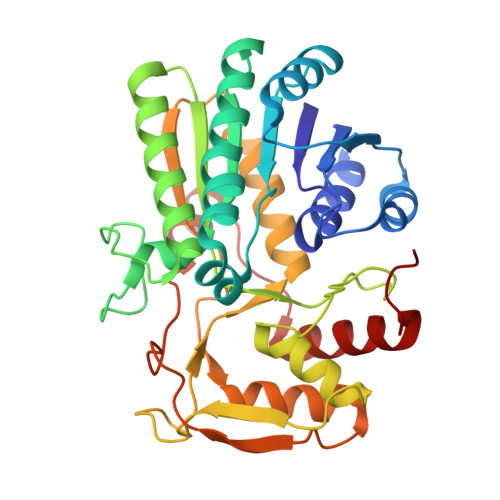Structural analysis of the Y299C mutant of Escherichia coli UDP-galactose 4-epimerase. Teaching an old dog new tricks.
Thoden, J.B., Henderson, J.M., Fridovich-Keil, J.L., Holden, H.M.(2002) J Biological Chem 277: 27528-27534
- PubMed: 12019271
- DOI: https://doi.org/10.1074/jbc.M204413200
- Primary Citation of Related Structures:
1LRJ, 1LRK, 1LRL - PubMed Abstract:
UDP-galactose 4-epimerase catalyzes the interconversion of UDP-Gal and UDP-Glc during normal galactose metabolism. The mammalian form of the enzyme, unlike its Escherichia coli counterpart, can also interconvert UDP-GalNAc and UDP-GlcNAc. One key feature of the epimerase reaction mechanism is the rotation of a 4-ketopyranose intermediate in the active site. By comparing the high resolution x-ray structures of both the bacterial and human forms of the enzyme, it was previously postulated that the additional activity in the human epimerase was due to replacement of the structural equivalent of Tyr-299 in the E. coli enzyme with a cysteine residue, thereby leading to a larger active site volume. To test this hypothesis, the Y299C mutant form of the E. coli enzyme was prepared and its three-dimensional structure solved as described here. Additionally, the Y299C mutant protein was assayed for activity against both UDP-Gal and UDP-GalNAc. These studies have revealed that, indeed, this simple mutation did confer UDP-GalNAc/UDP-GlcNAc converting activity to the bacterial enzyme with minimal changes in its three-dimensional structure. Specifically, although the Y299C mutation in the bacterial enzyme resulted in a loss of epimerase activity with regard to UDP-Gal by almost 5-fold, it resulted in a gain of activity against UDP-GalNAc by more than 230-fold.
- Department of Biochemistry, University of Wisconsin, Madison, WI 53706-1544, USA.
Organizational Affiliation:




















